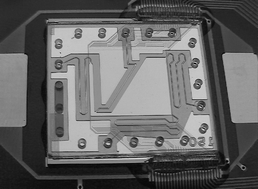Microfluidic channel fabrication in dry film resist for production and prototyping of hybrid chips
Abstract
Microfluidic networks are patterned in a dry film resist (Ordyl SY300/550) that is sandwiched in between two substrates. The technique enables fabrication of complex biochips with active elements both in the bottom and the top substrate (hybrid chips). The resist can be double bonded at relatively low temperatures without the use of extra adhesives. A postbake transfers the resist into a rigid structure. The resist is qualified in terms of resolution, biocompatibility and fluidic sealing. Fabrication in both a fully equipped cleanroom setting as well as a minimally equipped laboratory is described. The technique is applied for dielectrophoresis-based cell separation systems and a


 Please wait while we load your content...
Please wait while we load your content...